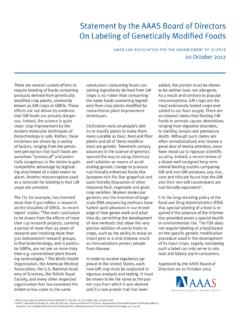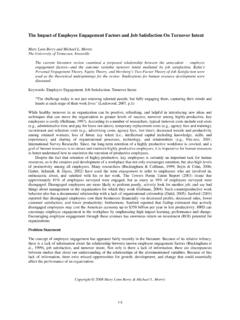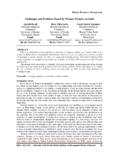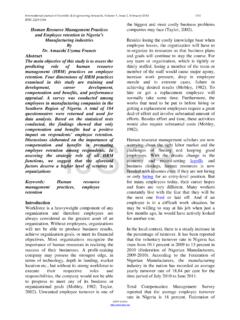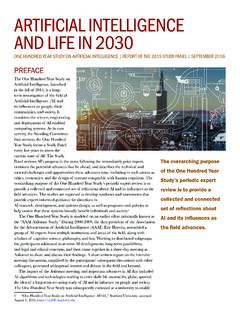Transcription of ARTIFICIAL INTELLIGENCE AND COVID -19: …
1 ARTIFICIAL INTELLIGENCE AND COVID -19: APPLICATIONS AND IMPACT ASSESSMENT ARTIFICIAL INTELLIGENCE AND COVID -19: APPLICATIONS AND IMPACT ASSESSMENT Page left blank intentionally ARTIFICIAL INTELLIGENCE AND COVID -19: APPLICATIONS AND IMPACT ASSESSMENT 1 This report was produced as a part of the ARTIFICIAL INTELLIGENCE : Applications/Implications (AI) Initiative ( ) of the American Association for the Advancement of Science (AAAS). AAAS is the world s largest multidisciplinary scientific membership organization. The goal of the AAAS (AI) Initiative is to contribute to the responsible development and application of ARTIFICIAL INTELLIGENCE (AI) such that AI alleviates rather than exacerbates social inequalities.
2 Report prepared by: Ilana Harrus, Senior Program Associate (AAAS) Jessica Wyndham, Program Director (AAAS) Acknowledgments: We gratefully acknowledge members of the (AI)2 Initiative Advisory Group and of the AAAS Committee on Scientific Freedom and Responsibility who provided input and guidance. In particular, we wish to thank Ronald Arkin, Solon Barocas, Kadija Ferryman, Noreen Herzfeld, Camara Jones, Alexa Koenig, Daniel Kracov, Mark Latonero, Camille Nebeker, Frank Pasquale, David Robinson, Neal Rubin, Dietram Scheufele, Jeramie Scott, and Daniel Weitzner. Special thanks are also due to Theresa Harris and Curtis L. Baxter III for their feedback on the report.
3 Funding for the AI Initiative was provided in part by Microsoft. Disclaimer: The opinions, findings, and conclusions or recommendations expressed in this publication do not necessarily reflect the views of the AAAS Board of Directors, its council and membership, or Microsoft. Contact: AAAS welcomes comments and questions regarding its work. Please send information, suggestions, and any comments to the AI2 project at: Cite as: AAAS (2021). ARTIFICIAL INTELLIGENCE and COVID -19: Applications and Impact Assessment. (Report prepared by Ilana Harrus and Jessica Wyndham under the auspices of the AAAS Scientific Responsibility, human Rights and Law Program). American Association for the Advancement of Science ARTIFICIAL INTELLIGENCE : Applications/Implications Scientific Responsibility, human Rights and Law Program 1200 New York Avenue, NW Washington, DC, 20005 USA Cover design credit: Paula Fry, Lead Art Associate (AAAS) Copyright 2021 ARTIFICIAL INTELLIGENCE AND COVID -19: APPLICATIONS AND IMPACT ASSESSMENT 2 Table of Contents ACRONYMS.
4 4 ABSTRACT .. 5 EXECUTIVE SUMMARY .. 6 INTRODUCTION .. 11 1 COMPILATIONS AND ASSESSMENT OF AI APPLICATIONS LINKED TO COVID -19 .. 12 METHODOLOGY .. 12 SURVEY OF SURVEYS .. 12 FORECASTING .. 16 DIAGNOSIS .. 17 CONTAINMENT AND MONITORING .. 18 DRUG DEVELOPMENTS AND TREATMENTS .. 19 MEDICAL AND SOCIAL MANAGEMENT .. 21 2 SELECTION PROCESS: METHODOLOGY AND RESULTS .. 22 3 IN-DEPTH EXAMINATION OF THE SELECTED APPLICATIONS .. 23 ETHICAL AND human RIGHTS FRAMEWORKS .. 23 SORTING APPLICATIONS .. 26 Triage Applications .. 26 Allocation of Resources .. 36 SURVEILLANCE APPLICATIONS .. 37 Contact Tracing .. 38 Geofencing / Green Passports .. 44 4 CONCLUSIONS.
5 46 5 MOVING FORWARD: PROPOSED RESEARCH AGENDA .. 47 TECHNICAL .. 48 ETHICAL, SOCIAL AND human RIGHT ISSUES .. 52 NEXT STEPS .. 54 6 BIBLIOGRAPHY .. 55 ARTIFICIAL INTELLIGENCE AND COVID -19: APPLICATIONS AND IMPACT ASSESSMENT 3 Table of Figures Figure 1: COVID -19 mortality rates per 100,000 cases by race and ethnicity in the US through March 2, 2021.. 11 Figure 2: Papers and AI techniques used against both virus and disease. The bars show the number of papers on research topics that do not rely on the use of AI (blue) and those that do (orange).. 13 Figure 3: AI techniques against COVID -19 and SARS-CoV-2 .. 15 Figure 4: A schematic view of the traditional drug development process.
6 20 Figure 5: A schematic representation of the relationships between Principles, Issues and Recommendations .. 24 Figure 6: A schematic decision tree to measure/ensure fairness .. 30 Figure 7: Comparison of potential legal outcome under 35 Figure 8: A schematic view of how contact tracing can 39 Figure 9: Estimate adoption rate of contact tracing applications .. 43 Fig e Time e ol ion of people a i de o a d ha ing da a f om con ac acing applica ion .. 45 ARTIFICIAL INTELLIGENCE AND COVID -19: APPLICATIONS AND IMPACT ASSESSMENT 4 Acronyms AAAS: American Association for the Advancement of Science AI: ARTIFICIAL INTELLIGENCE BLE: Bluetooth Low Energy CDC: Center for Disease Control and Prevention CORD-19: COVID -19 Open Research Dataset COVID : Coronavirus Disease CT: Computed Tomography EDI: EPIC Deterioration Index EHR: Electronic Health Record EPIC: Emergency Physicians Integrated Care ER: Emergency Room FDA: Food and Drug Administration FG-AI4H: Focus Group- ARTIFICIAL INTELLIGENCE for Health FDR: False Discovery Rate FN: False Negative FNR: False Negative Rate FP: False Positive FPR.
7 False Positive Rate GPS: Global Positioning System ICCPR: International Covenant on Civil and Political Rights ICESCR: International Covenant on Economic, Social and Cultural Rights ICU: Intensive Care Unit ITU: International Telecommunication Union ML: Machine Learning NIST: National Institute of Standards and Technology PACT East: Private Automated Contact Tracing PACT West: Privacy Sensitive Protocols And Mechanisms for Mobile Contact Tracing QR: Quick Response SOFA: Sequential Organ Failure Assessment SSRC: Social Science Research Council UNESCO: United Nations Educational, Scientific and Cultural Organization US: United States WHO: World Health Organization ARTIFICIAL INTELLIGENCE AND COVID -19: APPLICATIONS AND IMPACT ASSESSMENT 5 Abstract This report provides an overview of the multiple ways that ARTIFICIAL INTELLIGENCE has been either used or suggested as a tool in the context of the COVID -19 pandemic.
8 The report identifies and analyzes two specific classes of applications of AI that have already been implemented and which present potentially stark implications for marginalized and vulnerable populations (sorting and surveillance.) For each application, their technical attributes are detailed, and the ethical, human rights and differential impacts of these applications explored, drawing upon interviews conducted with experts in the field as well as a wide body of literature. Based on this analysis, a research agenda is proposed to support the fair, just, transparent, and accountable use of those AI applications in the future. The findings are intended to help raise awareness among populations impacted by the application of AI-based technologies in the current pandemic and in the future, to inform policy makers and health professionals who determine whether and how these tools are deployed during the current pandemic, during future public health crises, and in general, and to broaden the scope of understanding among developers and researchers in the AI community of the implications of the use of these AI-based technologies.
9 Keywords: ARTIFICIAL INTELLIGENCE , AI, COVID -19, Applications, Surveillance, Resource Allocations, Triage, Ethics, human Rights. ARTIFICIAL INTELLIGENCE AND COVID -19: APPLICATIONS AND IMPACT ASSESSMENT 6 Executive Summary As the COVID -19 pandemic struck, ARTIFICIAL INTELLIGENCE (AI) quickly became central to the fight against the virus. From diagnosis to drug development, from forecasting the disease's spread to monitoring and surveillance of the population, the tools of AI were called upon to address the scale and scope of the pandemic. This report catalogues the many and varied uses of AI in the pandemic, outlines the relevant ethical and human rights frameworks, identifies those applications that raise particular ethical and human rights concerns, and explores in detail those concerns as they relate to two general broad categories of application: those for sorting/triage, and those for surveillance.
10 The goal of the report is to inform the future development, use, and policies associated with these applications, whether in the current or future health crisis. Section One is a survey of the different AI applications used or suggested in the fight against COVID -19 and a classification of those applications according to their field of use. The literature reveals no consensus taxonomy of these applications. The taxonomy adopted for this report classifies AI applications into five large classes: forecasting, diagnosis, containment and monitoring, drug development and treatments, and social and medical management. This classification emphasizes applications implemented at scale in the United States (US).



